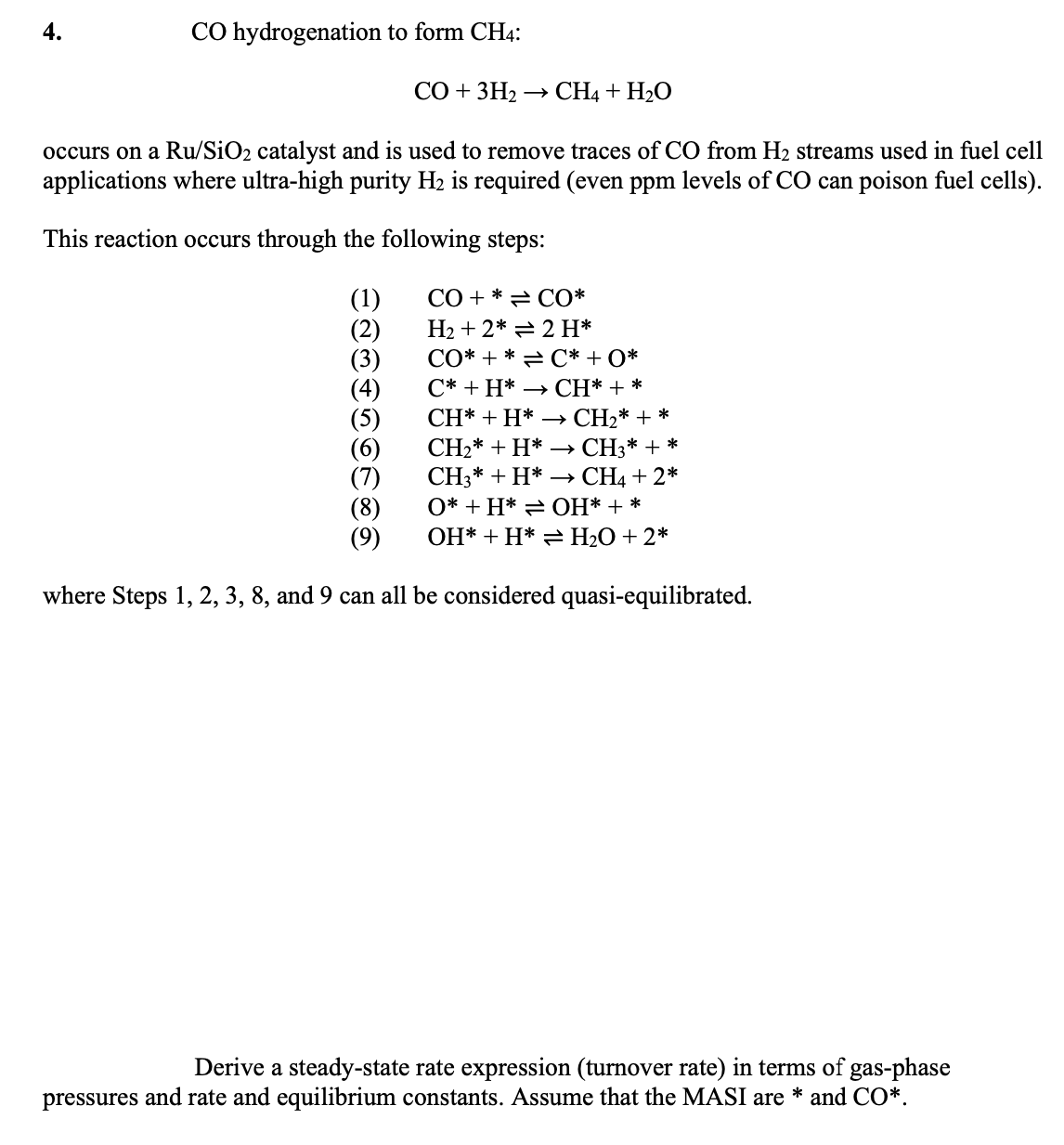4. CO hydrogenation to form CH4: → CO+ 3H2 CH4 + H2O occurs on a Ru/SiO2 catalyst and is used to remove traces of CO from H2 streams used in fuel cell applications where ultra-high purity H2 is required (even ppm levels of CO can poison fuel cells). This reaction occurs through the following steps: (1) (2) CO+* CO* H2 + 2* 2 H* CO*+* C*+0* C* H* → CH*+* CH* + H* → CH2*+* CH2* + H* → CH3*+* CH3* + H* → CH4 + 2* O* + H* OH*+* OH* + H* = H₂O + 2* where Steps 1, 2, 3, 8, and 9 can all be considered quasi-equilibrated. Derive a steady-state rate expression (turnover rate) in terms of gas-phase pressures and rate and equilibrium constants. Assume that the MASI are * and CO*.
4. CO hydrogenation to form CH4: → CO+ 3H2 CH4 + H2O occurs on a Ru/SiO2 catalyst and is used to remove traces of CO from H2 streams used in fuel cell applications where ultra-high purity H2 is required (even ppm levels of CO can poison fuel cells). This reaction occurs through the following steps: (1) (2) CO+* CO* H2 + 2* 2 H* CO*+* C*+0* C* H* → CH*+* CH* + H* → CH2*+* CH2* + H* → CH3*+* CH3* + H* → CH4 + 2* O* + H* OH*+* OH* + H* = H₂O + 2* where Steps 1, 2, 3, 8, and 9 can all be considered quasi-equilibrated. Derive a steady-state rate expression (turnover rate) in terms of gas-phase pressures and rate and equilibrium constants. Assume that the MASI are * and CO*.
Introduction to Chemical Engineering Thermodynamics
8th Edition
ISBN:9781259696527
Author:J.M. Smith Termodinamica en ingenieria quimica, Hendrick C Van Ness, Michael Abbott, Mark Swihart
Publisher:J.M. Smith Termodinamica en ingenieria quimica, Hendrick C Van Ness, Michael Abbott, Mark Swihart
Chapter1: Introduction
Section: Chapter Questions
Problem 1.1P
Related questions
Question

Transcribed Image Text:4.
CO hydrogenation to form CH4:
→
CO+ 3H2 CH4 + H2O
occurs on a Ru/SiO2 catalyst and is used to remove traces of CO from H2 streams used in fuel cell
applications where ultra-high purity H2 is required (even ppm levels of CO can poison fuel cells).
This reaction occurs through the following steps:
(1)
(2)
CO+*
CO*
H2 + 2* 2 H*
CO*+* C*+0*
C* H* → CH*+*
CH* + H* →
CH2*+*
CH2* + H* → CH3*+*
CH3* + H* →
CH4 + 2*
O* + H* OH*+*
OH* + H* = H₂O + 2*
where Steps 1, 2, 3, 8, and 9 can all be considered quasi-equilibrated.
Derive a steady-state rate expression (turnover rate) in terms of gas-phase
pressures and rate and equilibrium constants. Assume that the MASI are * and CO*.
Expert Solution
This question has been solved!
Explore an expertly crafted, step-by-step solution for a thorough understanding of key concepts.
This is a popular solution!
Trending now
This is a popular solution!
Step by step
Solved in 1 steps

Recommended textbooks for you

Introduction to Chemical Engineering Thermodynami…
Chemical Engineering
ISBN:
9781259696527
Author:
J.M. Smith Termodinamica en ingenieria quimica, Hendrick C Van Ness, Michael Abbott, Mark Swihart
Publisher:
McGraw-Hill Education

Elementary Principles of Chemical Processes, Bind…
Chemical Engineering
ISBN:
9781118431221
Author:
Richard M. Felder, Ronald W. Rousseau, Lisa G. Bullard
Publisher:
WILEY

Elements of Chemical Reaction Engineering (5th Ed…
Chemical Engineering
ISBN:
9780133887518
Author:
H. Scott Fogler
Publisher:
Prentice Hall

Introduction to Chemical Engineering Thermodynami…
Chemical Engineering
ISBN:
9781259696527
Author:
J.M. Smith Termodinamica en ingenieria quimica, Hendrick C Van Ness, Michael Abbott, Mark Swihart
Publisher:
McGraw-Hill Education

Elementary Principles of Chemical Processes, Bind…
Chemical Engineering
ISBN:
9781118431221
Author:
Richard M. Felder, Ronald W. Rousseau, Lisa G. Bullard
Publisher:
WILEY

Elements of Chemical Reaction Engineering (5th Ed…
Chemical Engineering
ISBN:
9780133887518
Author:
H. Scott Fogler
Publisher:
Prentice Hall


Industrial Plastics: Theory and Applications
Chemical Engineering
ISBN:
9781285061238
Author:
Lokensgard, Erik
Publisher:
Delmar Cengage Learning

Unit Operations of Chemical Engineering
Chemical Engineering
ISBN:
9780072848236
Author:
Warren McCabe, Julian C. Smith, Peter Harriott
Publisher:
McGraw-Hill Companies, The